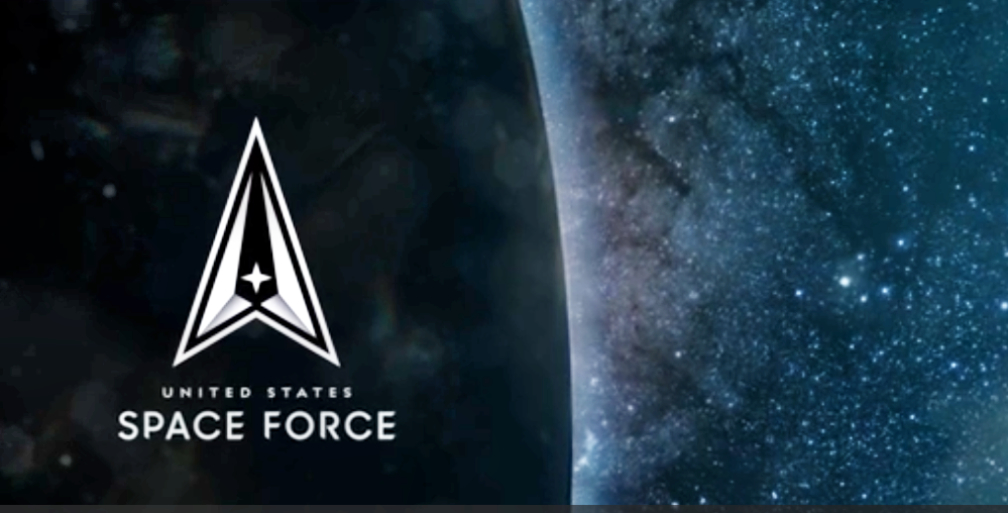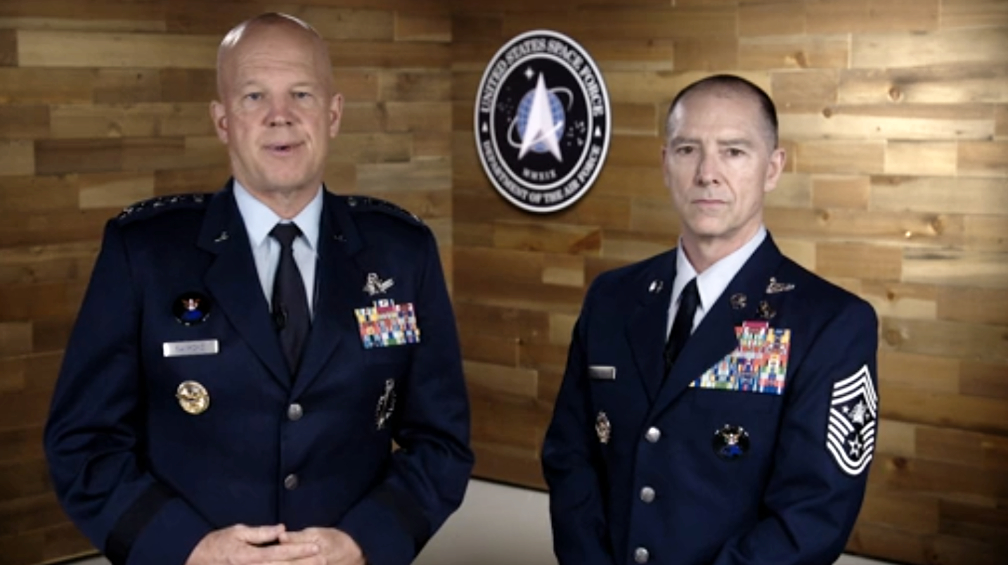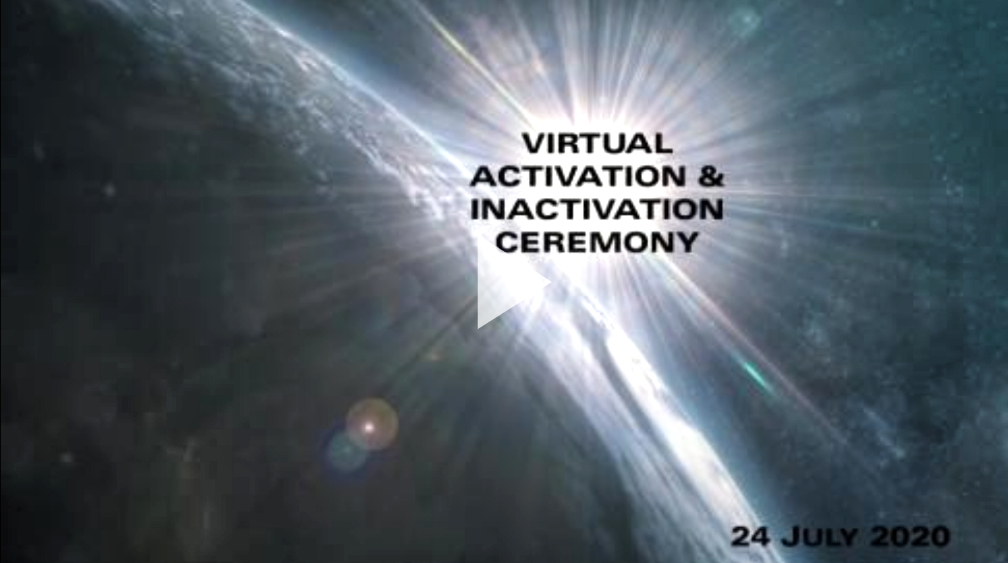
During a virtual pre-recorded ceremony on July 24, the U.S. Space Force executed numerous organization changes in its first realignment actions to transition from the previous Air Force major command structure into the new service’s flatter field organization structure that was announced on June 30.
When fully implemented, the field organization will consist of three echelons of command named field command, delta or garrison depending on focus, and squadron, eliminating one general officer echelon and one O-6 echelon of command.
“Today we take action, an important and significant step, towards the development of a 21st century service purpose-built to achieve speed, agility, and unity of effort,” said Gen. John “Jay” Raymond, Chief of Space Operations, in the recorded video. “This ceremony highlights the most significant restructure of space units since the establishment of the Air Force Space Command in 1982.”

In the ceremony, the Space Force inactivated three space wings and eight lower echelon commands, and in place activated Space Training and Readiness Delta Provisional, two garrison commands and eight mission deltas.
“The United States Space Force is being structured to organize, train, and equip a lean and agile force spreading the responsibilities across the future units to more quickly enable space operators to protect and defend America’s interests in space,” said Col. Suzy Streeter, the narrator for the ceremony.
STAR Delta Provisional will serve as the precursor organization to the eventual Space Training and Readiness Command field command, known as STARCOM. STARCOM will build lethality by developing combat-ready space forces and space warfighting capabilities in order to innovate and dominate in all domains – air, land, sea, space and cyberspace. STAR Delta Provisional will serve as the interim parent organization for a number of education, training, and operational test and evaluation units.
“Today’s activation of STAR Delta is a crucial first step in the command taking its place at the forefront of delivering a ready space force that is prepared to meet the challenges of defending the nation’s interests in space,” said Col. Pete Flores, Commander, STAR Delta.
The other two field commands will be Space Operations Command (SpOC) and Space Systems Command (SSC). SpOC will be responsible for organizing, training, and equipping fielded space forces who will execute space warfighting operations for combatant commanders, coalition partners, the joint force, and the nation. SSC will be responsible for developing, acquiring, fielding, and sustaining lethal and resilient space capabilities for warfighters.
As space operations are predominantly conducted by non-expeditionary forces, the Space Force’s new field structure effectively organizes space forces to fight in place within mission deltas and aligns installation support functions within garrisons. Air Force expertise, units and personnel will execute installation support functions under the command of the O-6 garrison commander through Air Force mission support groups, medical groups, and special staff.
Facilitating the transition to the two garrison commands established today, the 21st Space Wing, Peterson Air Force Base, Colorado, and the 50th Space Wing, Schriever AFB, Colorado, inactivated, and the Peterson-Schriever Garrison activated. The Peterson-Schriever Garrison will be headquartered at Peterson AFB and will also be responsible for Thule Air Base, Greenland; Cheyenne Mountain Air Force Station, Colorado; Kaena Point AFS, Hawaii and New Boston AFS, New Hampshire. This Garrison will support 16 additional mission locations around the world.
Additionally, the 460th Space Wing, Buckley AFB, Colorado, was inactivated, and the Buckley Garrison was activated. The garrison will be responsible for installation support to Cape Cod AFS, Massachusetts; Cavalier AFS, North Dakota; Clear AFS, Alaska, and will support 10 additional mission locations around the world.
Following the garrison activations, the Space Force established eight mission deltas. A space mission delta may be categorized as operational, support or specialized as determined by the collection of its subordinate units. Space deltas are designed to focus on executing complex missions to empower rapid decision making as an integral part of joint operations.
“Mission deltas, are similar to Army Combat Teams or Air Force Expeditionary Wings in that they enable laser focus on specific mission sets that pull together unique capabilities and highly-trained warfighters to deliver combat effects,” said Lt. Gen. David “DT” Thompson, Vice Commander, U.S. Space Force.
Mission delta activations and affiliated inactivations accomplished are:
- Activated Space Delta 2 (Space Domain Awareness) Inactivated 21st Operations Group at Peterson AFB
- Activated Space Delta 3 (Space Electronic Warfare) Inactivated 721st Operations Group at Peterson AFB
- Activated Space Delta 4 (Missile Warning) Inactivated 460th Operations Group at Buckley AFB
- Activated Space Delta 5 (Command and Control) Inactivated 614th Air Operations Center at Vandenberg AFB, California
- Activated Space Delta 6 (Cyberspace Operations) Inactivated 50th Network Operations Group at Schriever AFB
- Activated Space Delta 7 (Intelligence, Surveillance, and Reconnaissance) in partnership with the 544th Intelligence, Surveillance, and Reconnaissance Group at Peterson AFB
- Activated Space Delta 8 (Satellite Communications/Navigation Warfare) Inactivated 50th Operations Group at Schriever AFB
- Activated Space Delta 9 (Orbital Warfare) Inactivated 750th Operations Group at Schriever AFB
Space Force Senior Enlisted Advisor Chief Master Sgt. Roger A. Towberman had words of advice for these new command teams as they take on the role of not only leading these new units, but also unleashing the potential within space professionals to build the Space Force for tomorrow.
“We’re moving forward, and we are encouraging and embracing the ideas of our men and women in uniform to build a modern and digital Space Force,” Towberman said. “To our newest delta commanders and senior enlisted leaders, you have the unique opportunity to inspire and lead space professionals into a new era, ripe with opportunity.”
Finally, concurrent to this ceremony, some space-related units were re-aligned to the Space Force. These units, until now, belonged to other Air Force major commands rather than the former Air Force Space Command, meaning they were not assigned to USSF upon establishment of the new service.
Units realigned from the Air Force to the Space Force effective today include:
- National Security Space Institute
- U.S. Air Force Warfare Center Detachment 1
- 705th Combat Training Squadron Operating Location Alpha
- 25th Space Range Squadron
- 527th Space Aggressor Squadron
As these units and mission sets realign to the Space Force, military and civilian personnel in those units will also be assigned to the service. This realignment will not result in any immediate changes to personnel assignment or physical location.
Additional unit transfers will be announced as they are finalized.
Raymond closed the ceremony highlighting the new commanders’ opportunity to integrate space power into the strategic environment, building a comprehensive military advantage in space.
“Your charge is simple – to lead, inspire, and prepare our space forces to win in an era of contested space operations,” said Raymond. “The joint force is counting on you to be bold and agile in the face of threats and to deliver war-winning capabilities to our forces, our allies, and our partners operating around the earth. We know you will guarantee the Space Force is always above the next challenge.”
A video of the U.S. Space Force ceremony is available at this direct link…

